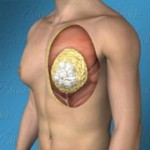Dr. Joseph T. Cruise Outlines a New Gynecomastia Classification System to Help Identify the Best Way to Treat Each Type
When male patients choose to have gynecomastia surgery, one of the most important aspects is properly determining the type of gynecomastia they have and the treatment options available to effectively correct the enlarged breasts. Dr. Joseph T. Cruise has implemented a new classification system outlining the varying types of gynecomastia with the recommended treatment for each.
Newport Beach, CA. (PRWEB) August 08, 2013
Why Have A Classification System?
In order to better educate his Los Angeles gynecomastia patients, as well as effectively treat their symptoms, Joseph T Cruise, MD has developed a comprehensive classification system, which separates each type by the cause and severity. Once the type is determined, the appropriate treatment option can be recommended. The goal is to prevent the need for repeat gynecomastia surgery resulting from unsatisfactory results. Too often, surgeons address most types of gynecomastia with liposuction alone, which may leave behind some residual breast tissue that often has to be removed as a secondary procedure.
“Creating a more thorough system for classifying the various types of gynecomastia allows me to pinpoint the exact treatment necessary to provide my patients with optimal results,” stated Joseph T Cruise, MD.
For more information, please visit:
https://orangecountycosmeticsurgery.com/gynecomastia-overview/
The Gynecomastia Classification System
The classification system divides enlarged male breasts into four basic types; puffy nipple gynecomastia, classic gynecomastia, fatty gynecomastia and saggy gynecomastia. Each of these gynecomastias have a different cause and, thus, should be treated differently. Puffy nipple gynecomastia is composed almost exclusively of gland. Since liposuction is ineffective at removing gland, puffy nipple requires surgical excision.
Classic gynecomastia, which is the most common, consists of primarily excess gland but also has a fatty component. Liposuction alone is capable of removing this fatty component but the breast tissue gland is left behind. Most patients will not be satisfied with this result. For this reason, Joseph T Cruise, MD strongly recommends surgical excision for classic gynecomastia.
Fatty gynecomastia, as the name suggests, is composed primarily of fat and does respond well to liposuction alone. These patients tend to be between the ages of 30-45 and are above their ideal body weight.
The most complex type of gynecomastia is saggy gynecomastia. Proper treatment involves not only removing the volume (fatty or gland) but also requires removing skin. These patients are usually either older or have lost a considerable amount of weight resulting in a skin excess.
Proper treatment of gynecomastia requires first identifying exactly the underlying cause. Being able to classify each patient properly is essential to obtain optimal results and avoid the need for revision surgery.
Schedule a Consultation
To learn more about your plastic surgery options, schedule a consultation with Dr. Cruise. Call our Newport Beach, CA office at (949) 446-1421 or contact us online. Out-of-town patients can also follow our fast-track online consultation process to find out if they are candidates for gynecomastia surgery with Dr. Cruise.



